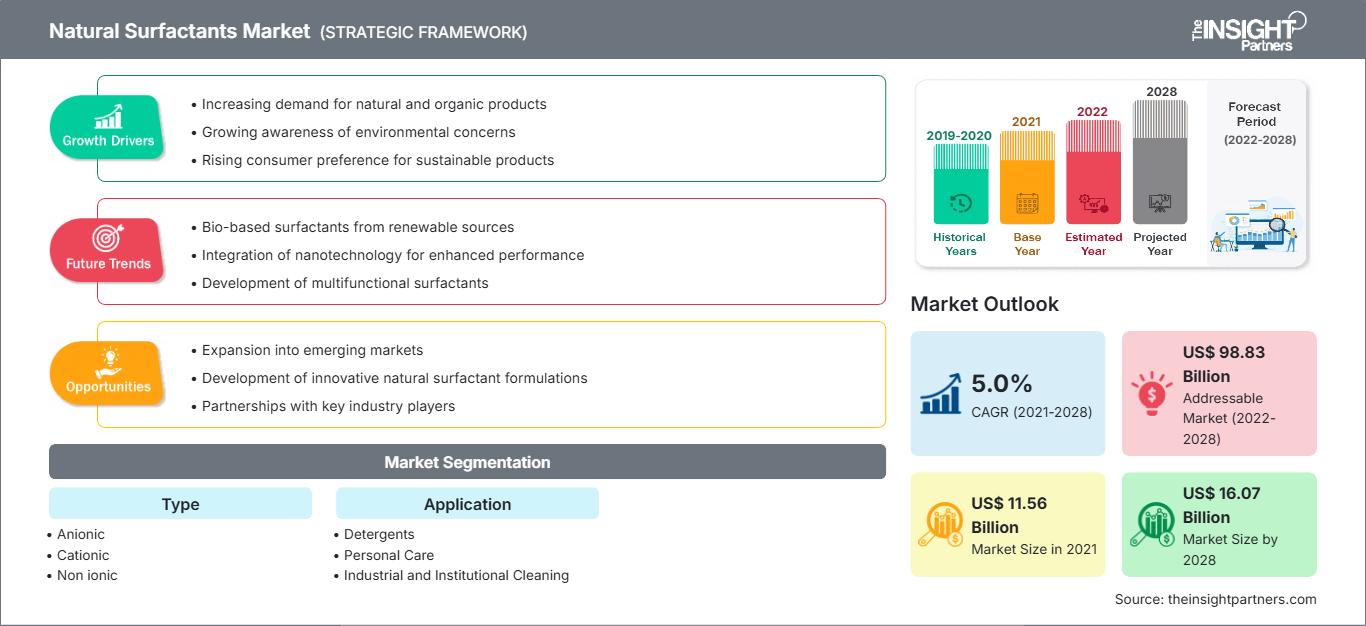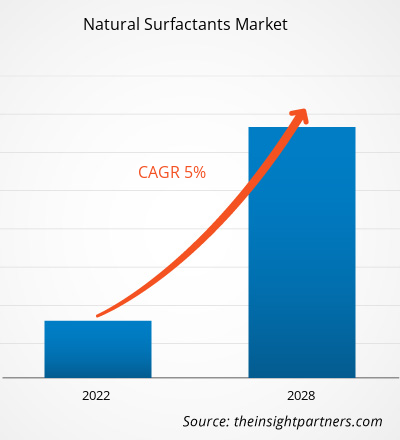[Rapport de recherche] Le marché des tensioactifs naturels devrait passer de 11 558,34 millions de dollars américains en 2021 à 16 069,28 millions de dollars américains en 2028 ; sa croissance devrait atteindre un TCAC de 5,0 % entre 2022 et 2028.
Les tensioactifs naturels sont dérivés de différents types de plantes. Les sources courantes incluent la noix de coco et le palmier, mais ils peuvent également être dérivés d'autres types de légumes et de fruits. De plus, les tensioactifs naturels peuvent également être produits à partir de déchets et de sous-produits industriels. Les tensioactifs naturels étaient plus facilement biodégradables que leurs homologues synthétiques en raison de leur origine biologique.
En 2021, la région Asie-Pacifique détenait la plus grande part de chiffre d'affaires du marché mondial des tensioactifs naturels. Les principaux facteurs qui stimulent le marché des tensioactifs naturels en Asie-Pacifique sont la prise de conscience croissante de leurs bienfaits et leur utilisation croissante dans diverses applications telles que les détergents, les cosmétiques et les soins personnels, le nettoyage industriel et l'agriculture. Les tensioactifs de synthèse, étant issus du pétrole, sont généralement non biodégradables et toxiques pour l'environnement. Les procédés de production des tensioactifs synthétiques et de leurs sous-produits peuvent être dangereux pour l'environnement. Par conséquent, la nécessité de protéger l'environnement est de plus en plus prise en compte. Par conséquent, l'utilisation des tensioactifs naturels est en hausse dans la région, ce qui stimule la croissance du marché des tensioactifs naturels en Asie-Pacifique.
Vous bénéficierez d’une personnalisation sur n’importe quel rapport - gratuitement - y compris des parties de ce rapport, ou une analyse au niveau du pays, un pack de données Excel, ainsi que de profiter d’offres exceptionnelles et de réductions pour les start-ups et les universités
Marché des tensioactifs naturels: Perspectives stratégiques

-
Obtenez les principales tendances clés du marché de ce rapport.Cet échantillon GRATUIT comprendra une analyse de données, allant des tendances du marché aux estimations et prévisions.
Impact de la pandémie de COVID-19 sur le marché des tensioactifs naturels
Avant la pandémie de COVID-19, le marché des tensioactifs naturels était principalement stimulé par leur utilisation croissante dans divers secteurs tels que les soins personnels, les détergents, le nettoyage industriel et institutionnel, les produits chimiques pour les champs pétrolifères, les produits chimiques agricoles, etc. Cependant, en 2020, plusieurs industries ont dû ralentir leurs activités en raison des perturbations des chaînes de valeur causées par la fermeture des frontières nationales et internationales. La pandémie de COVID-19 a provoqué des perturbations de la chaîne d'approvisionnement en matières premières clés et a entravé les processus de fabrication en raison des restrictions imposées par les autorités gouvernementales dans de nombreux pays. La demande de tensioactifs naturels de diverses industries a diminué en raison de la fermeture des industries.
La demande de produits d'hygiène personnelle et d'entretien ménager a augmenté en raison de la pandémie de COVID-19, ce qui a eu un impact positif sur la production de tensioactifs naturels pour les ménages et d'autres applications. De plus, les tensioactifs naturels jouent un rôle clé dans la lutte contre la pandémie. Les tensioactifs naturels courants sont utilisés dans les savons et autres produits d'hygiène personnelle, les lessives et les nettoyants pour surfaces solides pour désactiver le SARS-CoV-2 et l'éliminer de la peau et d'autres surfaces.
Informations sur le marché
Demande croissante de détergents pour applications ménagères
Avec la prévalence croissante des maladies infectieuses, en particulier de la COVID-19, les gens sont de plus en plus conscients de la propreté et de l'hygiène. L'importance de la désinfection des mains, de l'hygiène et de la propreté a augmenté en raison de l'émergence rapide de maladies infectieuses telles que le norovirus et la grippe. Le besoin de détergents pour applications ménagères augmente en raison de l'utilisation accrue de lessives et de produits d'entretien ménager.
Les détergents sont couramment utilisés pour le nettoyage car ils lient l'eau et l'huile, ce qui les rend efficaces contre les taches huileuses et la graisse. Les professionnels de la santé mènent des campagnes de sensibilisation à l'hygiène dans plusieurs pays en développement pour attirer l'attention des clients et les sensibiliser. En conséquence, les consommateurs La demande de produits de soins personnels et d'entretien ménager est en hausse.
Type Insights
Selon le type, le marché mondial des tensioactifs naturels est segmenté en tensioactifs anioniques, cationiques, non ioniques et amphotères. Le segment anionique détenait la plus grande part de marché des tensioactifs naturels en 2021. Les tensioactifs anioniques se caractérisent par un groupe polaire hydrophile chargé négativement. Ce sont les tensioactifs les plus couramment utilisés en raison de leur pouvoir nettoyant optimal et de la grande quantité de mousse produite. Ces tensioactifs sont les plus efficaces pour nettoyer, car ils nettoient par répulsion chargée. Les tensioactifs anioniques sont excellents pour éliminer la saleté, l'argile et certaines taches grasses. Ces tensioactifs anioniques sont présents dans les shampooings, les gels douche, les dentifrices, etc. Le glutamate, le cocoate de potassium, l'iséthionate et le coco sulfate de sodium sont quelques exemples de tensioactifs anioniques naturels.
Parmi les acteurs du marché mondial des tensioactifs naturels, on trouve BASF SE, Clariant AG, Croda International Plc, Dow Inc., KAO Corporation, Lankem Ltd., Solvay SA, Arkema, Stepan Company et Evonik Industries AG. Ces acteurs s'attachent à fournir des produits de haute qualité pour répondre à la demande des clients. Ils se concentrent également sur des stratégies telles que les investissements dans les activités de recherche et développement et les lancements de nouveaux produits.
Points forts du rapport
- Tendances progressives de l'industrie sur le marché des tensioactifs naturels pour aider les acteurs à développer des stratégies efficaces à long terme
- Stratégies de croissance des entreprises adoptées par les marchés développés et en développement
- Analyse quantitative du marché des tensioactifs naturels de 2020 à 2028
- Estimation de la demande mondiale de tensioactifs naturels
- Analyse des cinq forces de Porter pour illustrer l'efficacité des acheteurs et des fournisseurs opérant dans l'industrie
- Évolutions récentes pour comprendre le scénario de marché concurrentiel
- Tendances et perspectives du marché ainsi que facteurs qui stimulent et freinent la croissance du marché des tensioactifs naturels
- Aide au processus décisionnel en mettant en évidence les stratégies de marché qui sous-tendent l'intérêt commercial, conduisant à la croissance du marché des tensioactifs naturels
- Taille du marché des tensioactifs naturels à différents nœuds
- Aperçu détaillé et segmentation du marché, ainsi que la dynamique de l'industrie des tensioactifs naturels
- Taille du marché des tensioactifs naturels dans diverses régions avec des opportunités de croissance prometteuses
| Attribut de rapport | Détails |
|---|---|
| Taille du marché en 2021 | US$ 11.56 Billion |
| Taille du marché par 2028 | US$ 16.07 Billion |
| TCAC mondial (2021 - 2028) | 5.0% |
| Données historiques | 2019-2020 |
| Période de prévision | 2022-2028 |
| Segments couverts |
By Type
|
| Régions et pays couverts |
Amérique du Nord
|
| Leaders du marché et profils d'entreprises clés |
|
Densité des acteurs du marché des tensioactifs naturels : comprendre son impact sur la dynamique des entreprises
Le marché des tensioactifs naturels connaît une croissance rapide, portée par une demande croissante des utilisateurs finaux, due à des facteurs tels que l'évolution des préférences des consommateurs, les avancées technologiques et une meilleure connaissance des avantages du produit. Face à cette demande croissante, les entreprises élargissent leur offre, innovent pour répondre aux besoins des consommateurs et capitalisent sur les nouvelles tendances, ce qui alimente la croissance du marché.
- Obtenez le Marché des tensioactifs naturels Aperçu des principaux acteurs clés
Marché mondial des tensioactifs naturels
Par type
- Anionique
- Glutamate
- Cocoate de potassium
- Iséthionate
- Autres
- Cationique
- Isoleucinate de brassicyle ésylate
- Dialkylester Méthosulfate d'ammonium
- Esterquat Chlorure de benzalkonium
- Polyquaternium
- CTAC (Chlorure de cétrimonium)
- BTAC (Chlorure de béhentrimonium)
- Autres
- Non ioniques
- Saponines
- Glucosides
- Glycérides
- Éthoxylates
- Cocamide MEA (CMEA)
- Cocamide DEA (CDEA)
- Autres
- Amphotériques
- Bétaïnes
- Amphoacétates
- Sultaïnes
- Oxydes d'amine et autres
Par application
- Détergents
- Soins personnels
- Nettoyage industriel et institutionnel
- Produits chimiques pour champs pétrolifères
- Produits chimiques agricoles
- Autres
Profils d'entreprise
- BASF SE
- Clariant AG
- Croda International Plc
- Dow Inc.
- KAO Corporation
- Lankem Ltd.
- Solvay SA
- Arkema
- Stepan Company
- Evonik Industries AG
- Analyse historique (2 ans), année de base, prévision (7 ans) avec TCAC
- Analyse PEST et SWOT
- Taille du marché Valeur / Volume - Mondial, Régional, Pays
- Industrie et paysage concurrentiel
- Ensemble de données Excel
Rapports récents
Témoignages
Raison d'acheter
- Prise de décision éclairée
- Compréhension de la dynamique du marché
- Analyse concurrentielle
- Connaissances clients
- Prévisions de marché
- Atténuation des risques
- Planification stratégique
- Justification des investissements
- Identification des marchés émergents
- Amélioration des stratégies marketing
- Amélioration de l'efficacité opérationnelle
- Alignement sur les tendances réglementaires






















 Obtenez un échantillon gratuit pour - Marché des tensioactifs naturels
Obtenez un échantillon gratuit pour - Marché des tensioactifs naturels